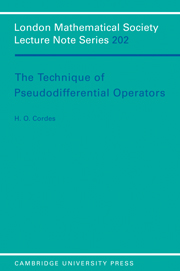Book contents
- Frontmatter
- Contents
- Preface
- Chapter 0 Introductory discussions
- Chapter 1 Calculus of pseudodifferential operators
- Chapter 2 Elliptic operators and parametrices in ℝn
- Chapter 3 L2-Sobolev theory and applications
- Chapter 4 Pseudodifferential operators on manifolds with conical ends
- Chapter 5 Elliptic and paraolic problems
- Chapter 6 Hyperbolic first order systems
- Chapter 7 Hyperbolic differential equations
- Chapter 8 Pseudodifferential operators as smooth operators of L(H)
- Chapter 9 Particle flow and invariant algebra of a semi-strictly hyperbolic system; coordinate invariance of Opψxm.
- Chapter 10 The invariant algebra of the Dirac equation
- References
- Index
Chapter 4 - Pseudodifferential operators on manifolds with conical ends
Published online by Cambridge University Press: 09 February 2010
- Frontmatter
- Contents
- Preface
- Chapter 0 Introductory discussions
- Chapter 1 Calculus of pseudodifferential operators
- Chapter 2 Elliptic operators and parametrices in ℝn
- Chapter 3 L2-Sobolev theory and applications
- Chapter 4 Pseudodifferential operators on manifolds with conical ends
- Chapter 5 Elliptic and paraolic problems
- Chapter 6 Hyperbolic first order systems
- Chapter 7 Hyperbolic differential equations
- Chapter 8 Pseudodifferential operators as smooth operators of L(H)
- Chapter 9 Particle flow and invariant algebra of a semi-strictly hyperbolic system; coordinate invariance of Opψxm.
- Chapter 10 The invariant algebra of the Dirac equation
- References
- Index
Summary
Introduction.
In the present chapter we will focus on pseudo-differential operators on differentiable manifolds. We assume either that ω is compact -then our theory will not differ from others – or that ω is a noncompact Riemannian space with conical ends.
While the Fourier transform and, correspondingly, the concept of Fourier multiplier a(D) = F−1 a(M)F is meaningfull only for functions or distributions defined on ℝn, the kind of ψdo's we introduced has a natural environment on a type of differentiable manifold, to be studied. The reason: Our ψdo's of ch.2 are invariant under a type of coordinate transform (discussed in sec.3) while Fourier multipliers do not have this property.
In seel we discuss distributions on manifolds. A special type of ‘S-manifolds’ is preferred, allowing the definition of a class S(Ω) of rapidly decreasing functions. The linear functionals on S(Ω) will be our temperate distributions. For simplicity we will consider only manifolds Ω allowing a compactification Ω° to which the C∞ -structure can be extended – making Ω° a compact manifold with boundary. In essence then S(Ω) will be the class of functions over Ω vanishing of all orders on ∂Ω.
In sec.2 we will introduce ‘admissible’ charts, cut-off's, partitions, as well as admissible coordinate transforms, all designed to give S(Ω) similar properties than S(ℝn). In particular a Riemannian metric is introduced, making ω a space with conical ends. In sec.3 we prove invariance of pseudo-differential operators under admissible coordinate transforms.
See's 4 and 5 generalize the calculus of ψdo's to spaces with conical ends.
- Type
- Chapter
- Information
- The Technique of Pseudodifferential Operators , pp. 118 - 143Publisher: Cambridge University PressPrint publication year: 1995



